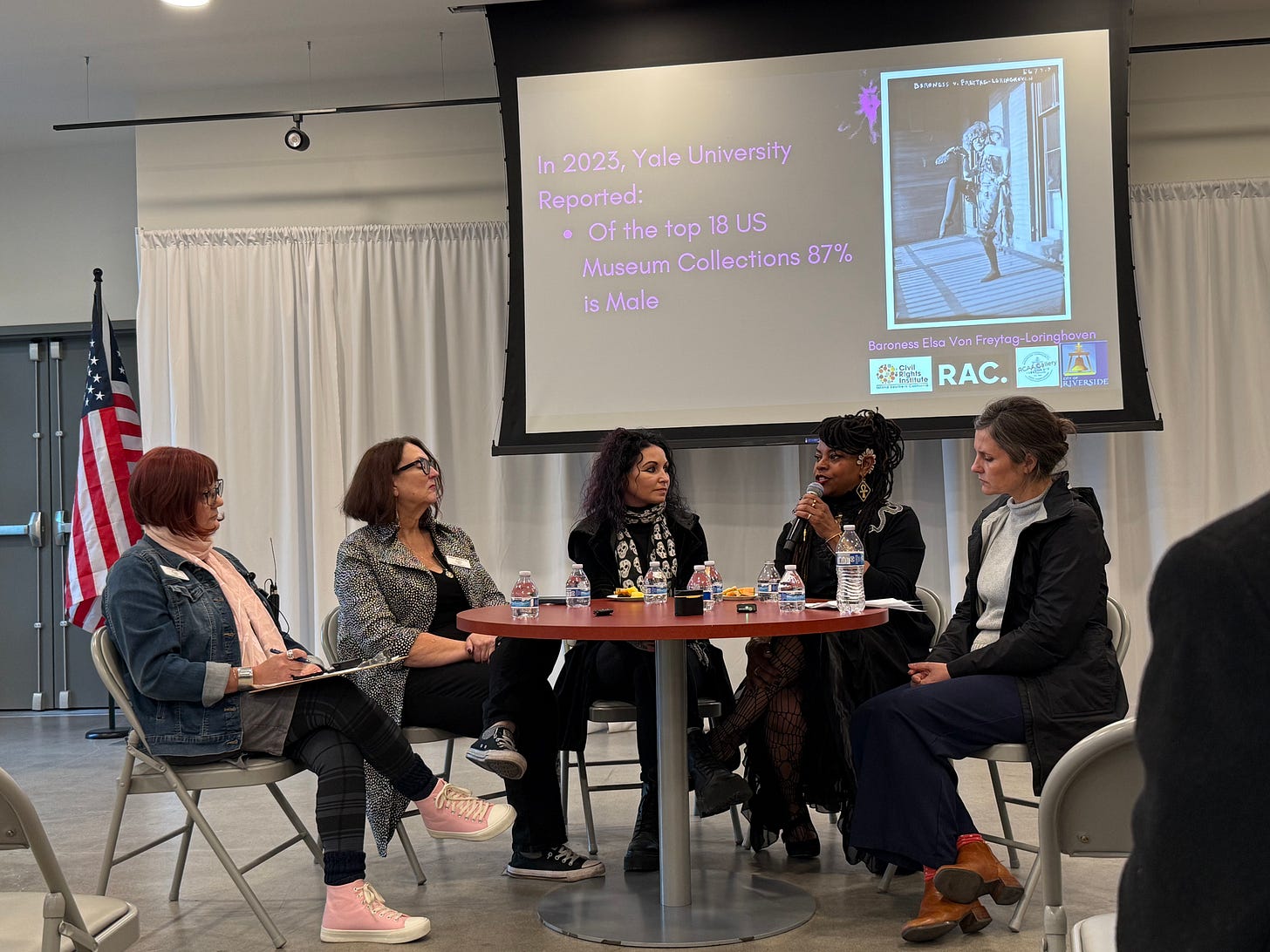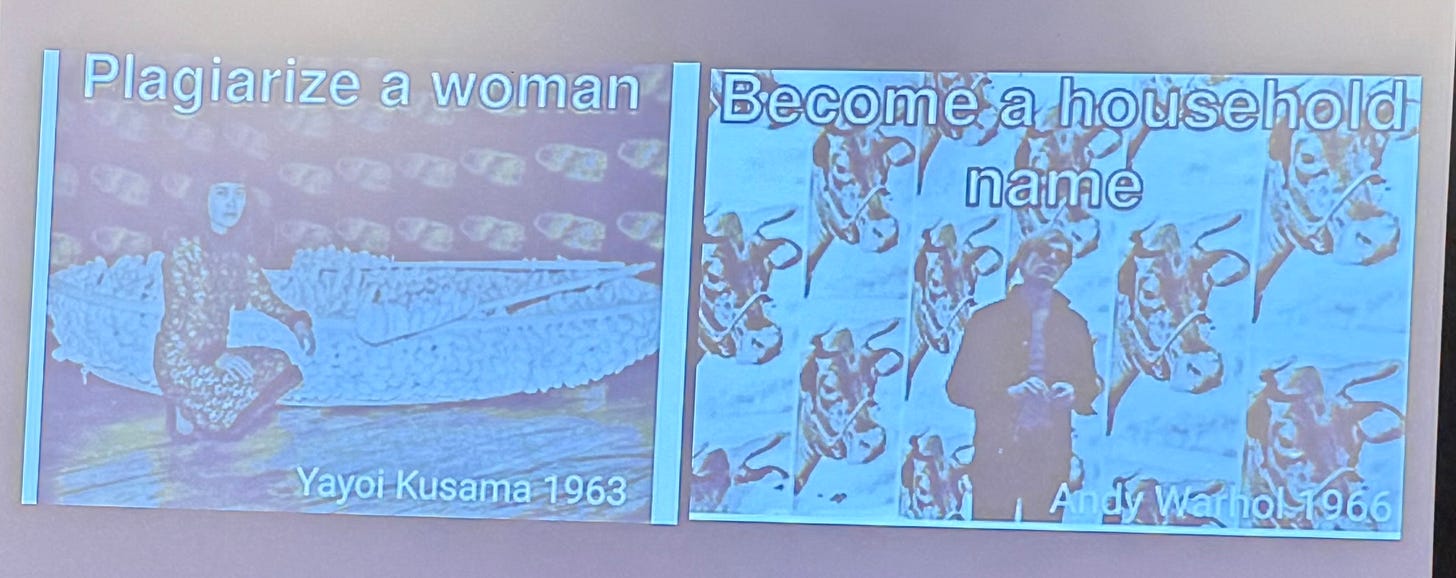“A data analysis of 18 major U.S. art museums found their collections are 87% male and 85% white,” was one of the slides that met the forty some attendees Thursday night last week at the panel discussion on gender gap in the arts.
I was recently invited to attend this presentation at The Civil Rights Institute in Riverside and oh boy, did I learn some cool facts from the five powerhouse ladies at the table.
The panel consisted of four women with an art career and a moderator:
Rachael A. Dzikonski - Executive director of Riverside Arts Council.
Nicole Green Hodges - Arts professor and historian.
Drew Oberjuerge - Executive director of Riverside Art Museum.
Barbara Simpson-Lara - Artist and filmmaker.
Moderator: Mindy Griffith - Artist.
In case you are wondering, let me make it clear from the onset that white men are not the majority of the art making people in the world. Women have always been making art. The art world has methodically excluded ingenious, innovative and incredible art coming from women and minorities. What I wonder is, why not invite more representation in? What is there to lose?
(From left, moderator Mindy Griffith, Barbara Simpson-Lara, Rachael A. Dzikonski, Nicole Green Hodges and Drew Oberjuerge)
The discussion began with the reasons for excluding women in the first place. Barbara Simpson explained how women artists are to this day afraid to speak out against abuse and discrimination because they are fearful of being excluded of opportunities. Even though this problem persists more so in Los Angeles than in Riverside, each panelist supported bringing awareness to the issue in order to do something about it.
The panel itself was a demonstration of how women leaders in the art world in a city like Riverside help mitigate persistent challenges of lack of representation.
“The whole reason that women are excluded is because there is inequality and people aren’t collaborating,” said Rachael A. Dzikonski. “If we foster a more collaborative community then people are not discriminated against.”
“I don’t feel like the gender gap has shrunk. I feel like it has evolved and is presenting itself depending on which area of art we are talking about,” said Nicole Green Hodges. “Every area we break into there is a whole new slew of nonsense that we get to deal with.”
From women entering the administrative roles in art to becoming art educators, there are challenges presented in each scenario.
Women have always been creating art, sometimes at the expense of their male counterparts, as exemplified by artist Margaret D. H. Keane whose husband claimed her art as his own and achieved commercial success in the 1960’s. Or how the Japanese artist Yayoi Kusama had her artwork plagiarized to great success by artists like Andy Warhol and Claes Oldenburg. These male artists never admitted where their ideas stemmed from or gave her any credit.
“[Warhol] plagiarized [Kusama], then ghosted her to the point where she had a full mental breakdown,” said Dzikonski. A recent exhibit (I think at the Broad but not sure) had the two of them side by side and when Dzikonski confronted the museum staff how harmful that was to Kusama’s art they seemed oblivious to the fact of the exploitation from Warhol. “It was disappointing that the curators did not know the history between those two artists,” she said.
“Now [Kusama] gets her credit, however it shouldn’t have taken so long,” added Drew Oberjuerge.
In essence art educators need to do their own research into the talented art world of women and bring that to their students. “Take those people you learned about and their back stories and bring them to [the classrooms],” said Hodges. “Regurgitate it to the baby birds,” she said with a laugh.
Hodges explained how there was an “Opposite and equal reaction” to the many exhibits full of white men’s artwork within certain fields (modernism, pop art etc.). The “Opposite and equal reaction” resulted in exhibits focusing on a minority or women artists instead of the artwork itself.
“The downfall of that was almost an equal disproportion of not being taken serious,” said Hodges. Artwork was then presented first and foremost with the gender marker for example instead of being seen for the arts’ inherent quality. “You would have a show that was about black women, and there would be 8,000 different types of art there and the only thing that rhymed was how the artist looked, so that’s ridiculous,” she said.
What the panel advocated for was balance. Creating art shows, art exhibits and portraying art history with an honest representation. Not because of a category (gender, minority etc.) but because it’s there: amazing art!
Don’t downplay it, display it, is what I thought.
I liked how Oberjuerge mentioned that museums and other institutions need to support women artists year round, not just during Women’s History Month.
“There are differences and there are things we might have to do outside of what a male has to do, but we also bring so much more at the same time,” she said. “There’s the balance.” One of the differences is making room for women to be caretakers while keeping careers in the art world.
The panel thought that young women today has it a little easier, that some battles are not as all encompassing as they once were. On the other side, the current political climate of decimating and cancelling anything supporting diversity, equity and inclusion, is a battle that needs to be taken seriously in the art world.
One way of making the art world aware of its lack of diversity was exemplified by the activist group, The Guerrilla Girls, from the 1980’s. The Guerrilla Girls plastered gorilla faces on the nudes in art exhibit in MoMA to raise awareness that less than 4% of the artists were females while 76% of the nudes in artworks were females. “Do females have to be nude to get into the MET Museum?” They asked.
When looking at art, Dzikonski reminded us that we each bring our own ‘life goggles’ along. Art is viewed through each individual’s life experience.
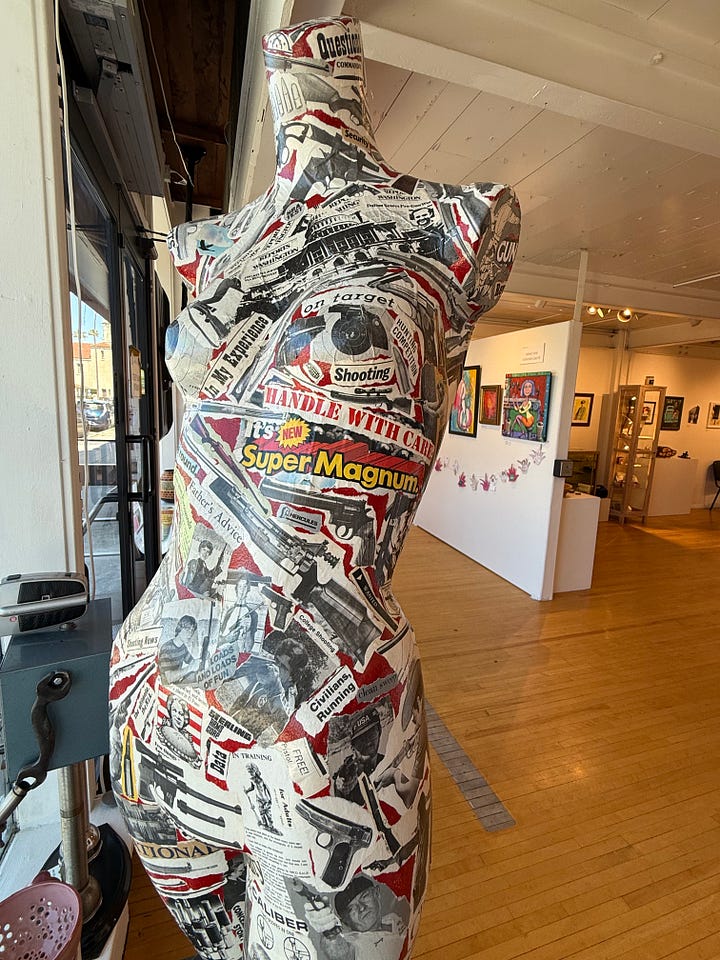
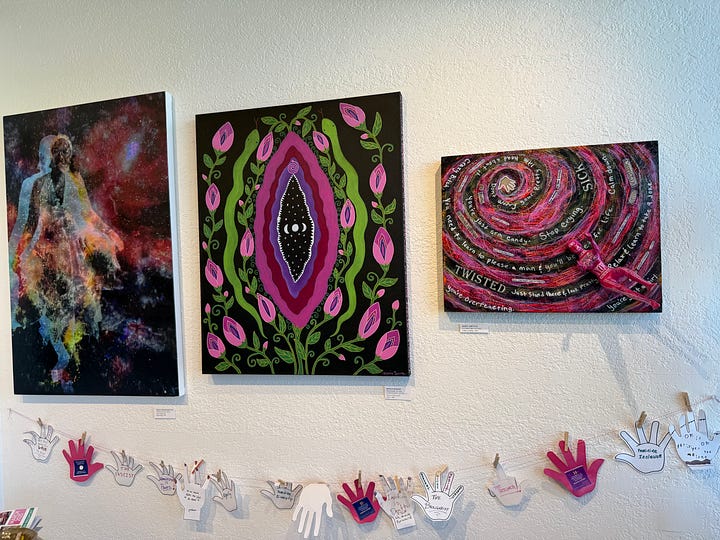
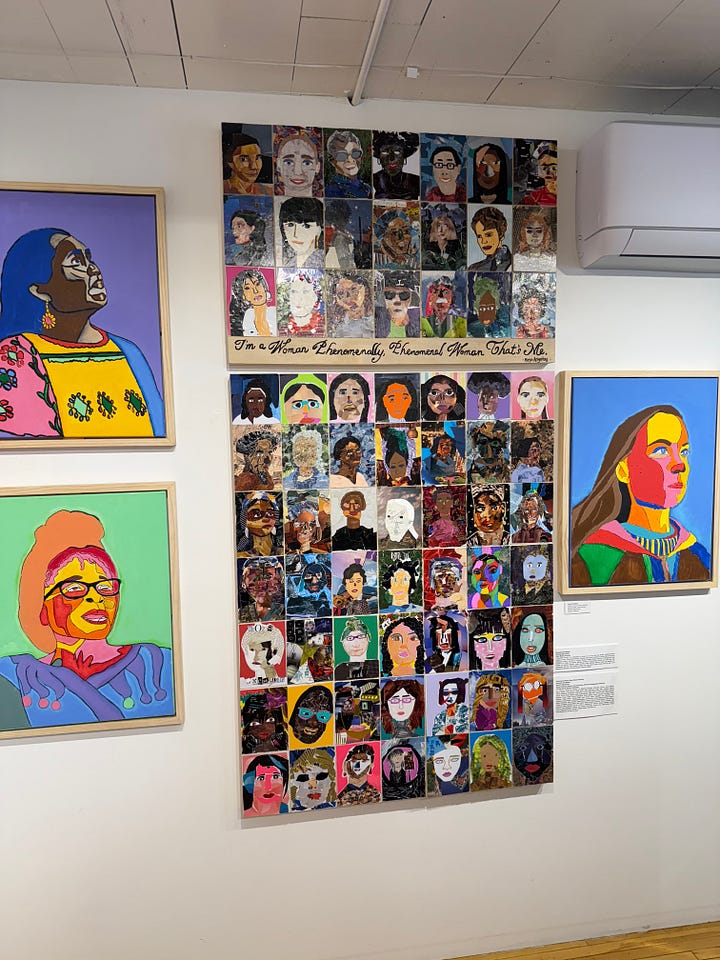
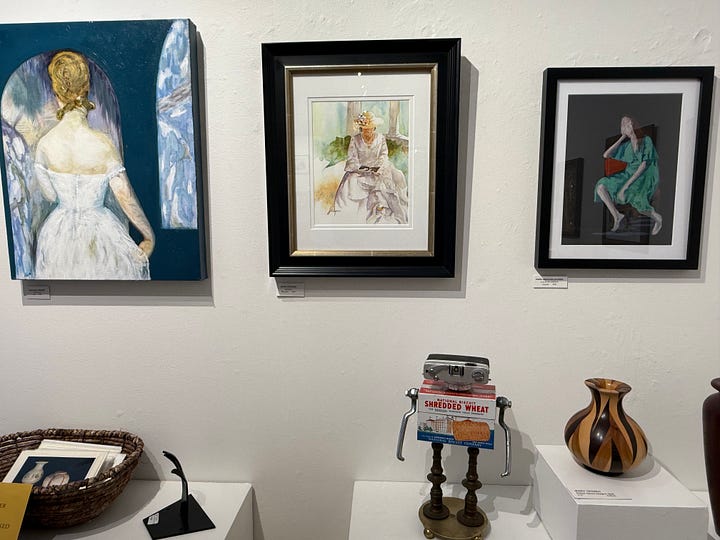
At the current art exhibit celebrating Women’s History Month at the Riverside Community Art Association, Dzikonski made a sculpture called ‘Le Regard Masculin.’
“It was supposed to be a statement on gender,” Dzikonski said. The mannequin is plastered in American Rifle Magazines from the 1970’s and 1980’s. “I tore out pages, and all of this political, societal and social expectations, school shootings, and all of this bled into the artwork and I didn’t think about it initially, those thoughts just bubbled up,” she said. “And I felt very uncomfortable afterwards.”
“So when you are looking at artwork or making artwork, that is a reflection of yourself,” she said. “It’s raw,” added Oberjuerge.
I headed over to the RCAA this week to look at the sculpture myself.
Above one breast was the word ‘target’ below it right at the spleen ‘handle with care,’ like a direct message at the violence committed towards women but why not handle them (and human beings in general) with care?! At the top of the throat I noticed the word ‘questions’ but there was no mouth or head for them to be uttered. Like how questioning the second amendment is so often silenced. At the belly button, the words ‘loads and loads of fun’ rang out surrounded by images of teen shooters and their guns. I looked at the sculpture and wished it would find a place in a museum somewhere. More people need to see it.
Talking about censorship, “It’s important to have undistilled female voices,” said Oberjuerge. Because as she explained what museums acquire into their collections later become history which is why it’s important to have correct representation. Not one sided.
It was heartwarming to see these professionals and the audience be cheerleaders of women in the arts world, promoting collaboration, mentorship and spaces for women (and other minorities) to thrive.
“One of the things I found here that I never found in L.A. was a sense of community, or a sense of family within my art. We have that here in Riverside. Most communities do not have that, and we are extremely fortunate to have that,” said Barbara Simpson-Lara. She encouraged artists to attend local art events and find their community.
Finally, one of the critical things in order to protect and assist a local art scene is also to support and buy local art. Sue Mitchell, local artist and art cheerleader in Riverside, reminded the attendees that buying a small art piece at the monthly Riverside Arts Walk could pay for a booth for the night and encouragement that their art is needed.
Here’s my two cents: In the world we live in these days, art is more important than ever. Art and artists are the bulwarks of telling the truth to power.
I like to think that we here in Redlands also are pretty good at supporting our local artists. We have two art galleries in downtown Redlands and numerous art walks and festivals sprinkled throughout the year. Maybe by sharing this piece Redlanders can visit Riverside to support their art scene and vice versa.
The event I covered here was put on not only by the Civil Rights Institute who by the way has an inspirational exhibit featuring homegrown heroes. But the event was also co-hosted by the Riverside Community Arts Association, The Riverside Arts Council and Riverside Art Museum.
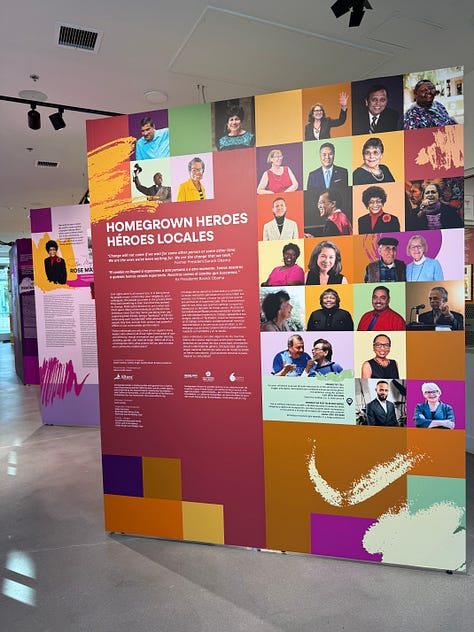

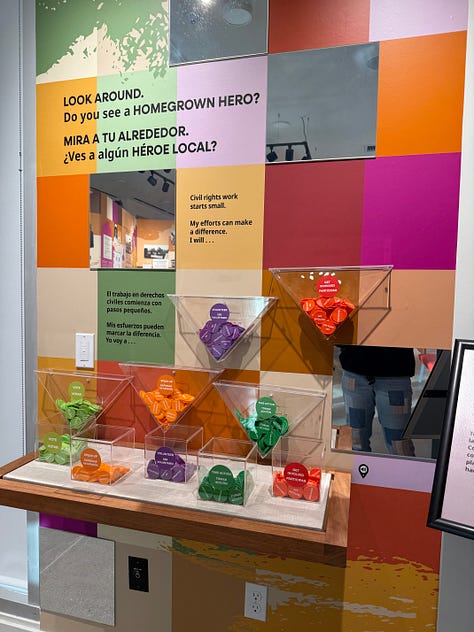
Bonus content: Did you know that Judy White was the first Black principal in San Bernardino? She developed programs that increased graduation rates for Black students from 65 to 91%. Or did you know that Vivian Stancil who has retinitis pigmentosa, still finished a college degree? She worked as an educator who opened a daycare center for abused children in Hesperia. And she learned to swim at age 50, earning numerous medals in the National Senior Games. And did you know Ben Jauregui, who works tirelessly to expand health care services for people with disabilities?
I thought a quote from Jauregui from the exhibit perfectly sums up the evening I had in Riverside.
“Disability rights are the same as other civil rights. It’s not asking for more. It’s not asking for less. It’s just asking to be treated the same” -Ben Jauregui
Remember, Riverside is less than half an hour away and is so worth a visit!
Thank you for reading. If you enjoyed this piece, please like below and subscribe to my Substack: www.siwheede.substack.com
I am close to 100 subscribers, can you help me get past this milestone? Please share.




